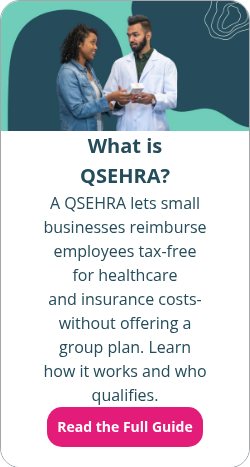What are reimbursable out-of-pocket costs?
By Holly Bengfort on May 23, 2025 at 9:15 AM
From unexpected medical bills to pricey prescriptions, out-of-pocket expenses can add up quickly. According to the KFF1, 61% of uninsured adults skipped or postponed getting the medical care they needed due to cost in 2024.
Employers can help relieve this financial burden on their employees by reimbursing some of their medical costs. Given that health coverage has consistently ranked as the most-requested employee benefit, this is an important perk to prioritize in your benefits package.
In this article, we'll go over which out-of-pocket expenses qualify for reimbursement and how you can offer reimbursements as an employee benefit.
In this blog post, you'll learn:
- What expenses insurance won't cover.
- The out-of-pocket limit for an individual and family health plan in 2025.
- What types of expenses are reimbursable with an HRA.
What are out-of-pocket costs?
People covered by health insurance still worry about medical costs. KFF found that approximately 50% of adults find it challenging to afford healthcare expenses, while 25% report that either they or a family member in their household faced difficulties paying for healthcare in the past year.
Out-of-pocket medical expenses refer to any healthcare cost that employer-sponsored or self-purchased health insurance doesn't cover.
These types of expenses include:
- Deductible payments
- Coinsurance costs
- Copay fees for covered services
- Costs for healthcare services that the insurer doesn’t cover
When health insurance companies refer to out-of-pocket maximums, they typically only refer to in-network care for essential health benefits. However, individuals may incur out-of-pocket expenses for other items and services, such as out-of-network care.
According to Healthinsurance.org2, the out-of-pocket limit for an individual is $9,200 in 2025. For a family plan, the out-of-pocket maximum is $18,400.
Reimbursable health expenses
More than 200 out-of-pocket expenses are eligible for reimbursement with a health reimbursement arrangement (HRA).
Here are a few examples of eligible expenses:
- Monthly premiums for health insurance
- Monthly premiums for vision and dental coverage
- Preventive services
- Emergency services
- Doctor visits
- Prescription drugs
- Over-the-counter medications
- Dental care
- Vision care
- Physical therapy
Reimbursement with an HRA
HRAs are employer-funded health benefits that allow employers to reimburse their employees for their qualifying medical expenses. All reimbursements made through an HRA are completely tax-free for the employer and tax-free for employees, too.
Many employers prefer HRAs as a cost-effective alternative to traditional group health insurance. But you can also pair an HRA with a group health plan to fill gaps in coverage.
PeopleKeep by Remodel Health offers three popular HRAs:
- Individual coverage HRA (ICHRA): The ICHRA works for employers of all sizes. You can offer it as a standalone benefit or as an alternative health benefit to employee classes that don't qualify for your current group health plan. Employees need their own qualifying individual health insurance to participate in this benefit.
- Qualified small employer HRA (QSEHRA): The QSEHRA is a standalone health benefit for small businesses with fewer than 50 full-time equivalent employees (FTEs). Unlike an ICHRA, employees don't need an individual plan to participate. They can participate if they have minimum essential coverage (MEC), including through a spouse's or parent's group healthcare plan.
- Group coverage HRA (GCHRA): The GCHRA, or integrated HRA, supplements a group health insurance policy. It covers out-of-pocket healthcare expenses not fully paid for by the group health insurance plan, like deductibles.
Reimbursement with a stipend
If you're looking for something simpler to offer your employees, a health employee stipend is an easy option that's free of the IRS regulations that come with HRAs.
A health stipend can bridge the financial gap for your employee's medical care. A health stipend is a fixed amount of money that you offer your employees to help cover their medical services and other related costs.
But health stipends are a taxable fringe benefit, unlike tax-advantaged HRAs. That means employees would need to report their stipend as income, like they would the rest of their paycheck, come tax season. A stipend also doesn't satisfy the Affordable Care Act's (ACA) employer mandate for organizations with 50 or more FTEs. Additionally, employers can't require employees to prove that they're using their stipend allowance toward health expenses.
Conclusion
The best way to reimburse your employees tax-free for their healthcare expenses, including their individual insurance coverage, is through an HRA. With our HRA administration software, you can offer a personalized health benefit that meets the needs of your unique team.
This blog article was originally published on February 14, 2022. It was last updated on May 22, 2025.
Check out more resources
See these related articles

Should you offer benefits to a 1099 employee?
Find out if you should offer benefits to 1099 employees. Learn the differences in benefit offerings between contractors and full-time employees.

Does QSEHRA disqualify employees from individual premium tax credits?
Learn how a QSEHRA affects premium tax credits. Understand if employees can still qualify for tax credits when offered a QSEHRA by their employer.

What is healthcare reimbursement?
Looking to reimburse your employees for their healthcare expenses? Learn everything you need to know about healthcare reimbursement.



